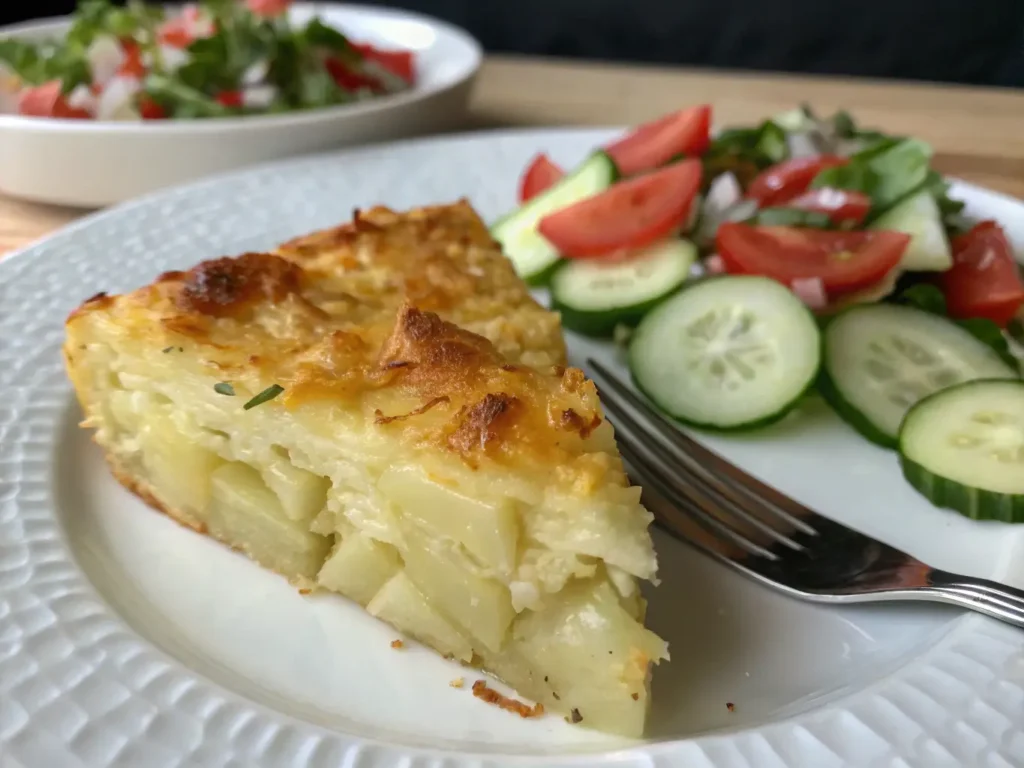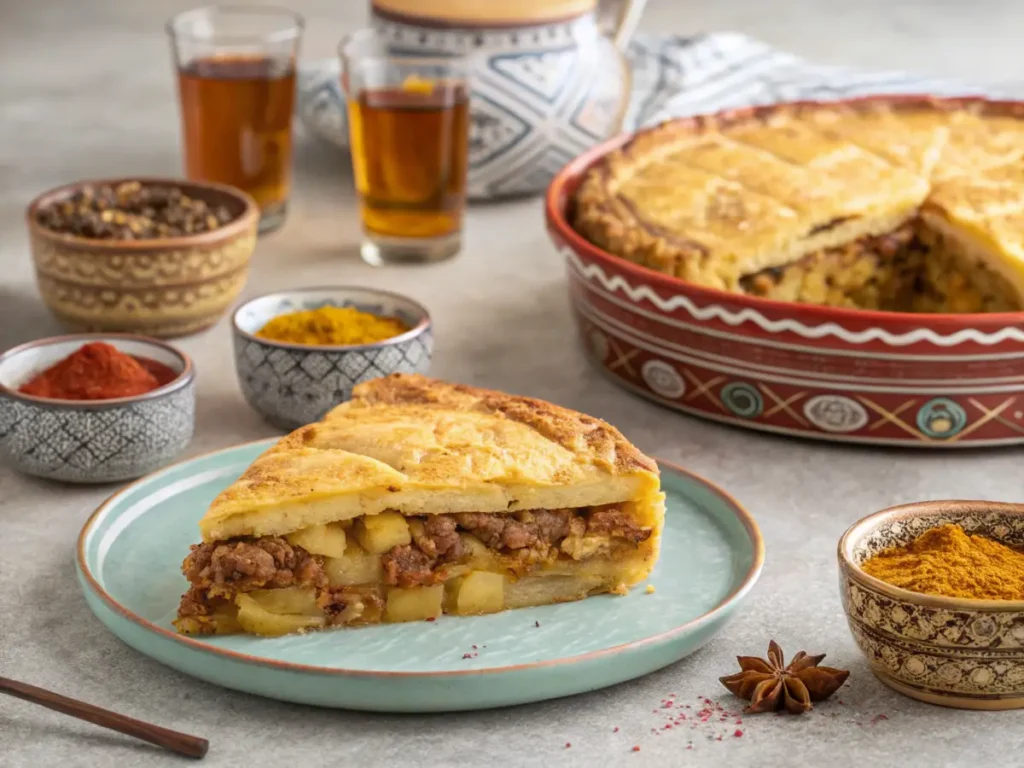Passover, or Pesach, is a time when Jewish families come together to celebrate faith, heritage, and tradition. A central part of the holiday is the preparation of symbolic and kosher meals. Among these cherished dishes, the Traditional Passover Potato Pie holds a special place. Known for its simplicity, versatility, and comforting flavors, this dish transcends generations and cultures, making it a beloved staple on Passover tables worldwide.
This article will delve into the cultural significance of the dish, its essential ingredients, classic recipes, Moroccan variations, tips for perfect preparation, and more. Whether you’re looking to recreate a family favorite or try something new, this guide has everything you need to elevate your Passover celebration.
Table of contents
The Cultural Significance of Passover Potato Pie
A Symbol of Simplicity and Resourcefulness
The Passover Potato Pie embodies the spirit of the holiday, emphasizing simplicity and resourcefulness. During Passover, leavened foods, or chametz, are forbidden, prompting the use of alternative ingredients that align with kosher guidelines. Potatoes, naturally gluten-free and widely available, have long served as a reliable substitute, becoming a cornerstone of many Passover recipes.
Bridging Cultural Traditions
Both Ashkenazi and Sephardic Jewish communities have embraced variations of potato pie, each adding their unique cultural twist. For Ashkenazi families, the dish is most often prepared as a kugel—a baked casserole featuring grated potatoes, eggs, and onions. This simple yet flavorful preparation has been a favorite for generations, offering a hearty side dish or main course.
In contrast, Sephardic Jewish traditions, particularly those with Moroccan roots, incorporate bold spices and layered flavors into their potato pies. These variations often include garlic, cumin, and turmeric, creating vibrant and aromatic dishes that reflect the culinary heritage of North African Jews.
Preserving Tradition Through Food
Passover dishes like the potato pie serve as a way to preserve and honor Jewish traditions. Passed down through families, these recipes connect modern celebrations with the rich history of the holiday. Whether enjoyed as a kugel, a layered pie, or a spiced variation, the Passover Potato Pie remains a timeless dish that unites Jewish families across the globe.
Essential Ingredients for Passover Potato Pie
The beauty of the Passover Potato Pie lies in its simplicity, relying on a handful of ingredients to create a dish that is both flavorful and satisfying. Each component plays a vital role in achieving the perfect balance of texture and taste.
The Role of Potatoes
Potatoes are the foundation of this dish, providing structure, starch, and creaminess. Russet potatoes are a popular choice due to their high starch content, which helps bind the ingredients naturally. Grating the potatoes finely ensures even cooking and a smooth, cohesive texture throughout the pie.
Explore how versatile potatoes can transform meals like quesadillas or dips. Best Tortilla For Quesadillas: Ultimate Guide.
Importance of Eggs
Eggs are indispensable in Passover potato pie, acting as the primary binder. Beaten eggs create a mixture that holds its shape when baked while also adding richness to the overall flavor. For a fluffier texture, consider whisking the eggs until slightly frothy before incorporating them into the mix.
Using Matzo Meal in Recipes
Matzo meal, a staple in Passover cooking, serves as a gluten-free alternative to flour in this dish. It provides structure and helps absorb excess moisture from the grated potatoes, ensuring the pie bakes evenly. If you’re looking for alternatives, potato starch or almond meal can work equally well, particularly for gluten-free or nut-based diets.
Learn why balancing flour and starch is key in dishes like Calzones and Pizza: Which is More Nutritious?
Enhancing Flavor with Onions and Seasonings
Grated onions add a subtle sweetness and depth of flavor to the potato pie. Kosher salt and freshly ground black pepper are traditional seasonings, but some recipes include garlic, paprika, or herbs like parsley to enhance the dish’s overall taste.
Discover how bold flavors elevate even simple recipes like meatloaf. Moist Meatloaf: What is the Secret?
Choosing the Right Fat
Traditional recipes often use schmaltz (rendered chicken fat) for its rich, savory flavor. However, olive oil is a common substitute, especially for those seeking a lighter or plant-based option. A drizzle of oil or schmaltz on top before baking helps achieve a golden-brown crust.
Classic Potato Kugel Recipe

The Classic Potato Kugel is a simple yet satisfying dish that has been a centerpiece on Passover tables for generations. With its crispy edges and soft, creamy interior, it’s a versatile recipe that can be enjoyed as a side dish or main course.
Ingredients for the Perfect Passover Potato Pie
To prepare a traditional potato kugel, you’ll need:
- 6 large Russet potatoes, peeled and grated
- 1 large onion, grated
- 4 large eggs, beaten
- 1/4 cup matzo meal
- 1/4 cup olive oil or schmaltz (chicken fat), plus extra for greasing
- 1 tsp kosher salt
- 1/2 tsp freshly ground black pepper
Step-by-Step Instructions of Passover Potato Pie
- Preheat the Oven
Set your oven to 375°F (190°C). Grease a 9×12-inch baking dish with olive oil or schmaltz to ensure the kugel doesn’t stick and to help develop a golden crust. - Grate the Potatoes and Onion
Use a box grater or food processor to finely grate the potatoes and onion. Once grated, transfer the mixture to a clean kitchen towel and squeeze out as much excess water as possible. This step is essential for achieving a fluffy, non-soggy kugel. - Prepare the Mixture
In a large mixing bowl, combine the grated potatoes and onion with beaten eggs, matzo meal, olive oil (or schmaltz), salt, and pepper. Mix thoroughly until all ingredients are well incorporated. - Pour Into the Baking Dish
Transfer the potato mixture to the prepared baking dish, spreading it evenly with a spatula. Drizzle a small amount of olive oil or schmaltz on top to enhance browning. - Bake to Perfection
Place the dish in the preheated oven and bake for 45–50 minutes. The kugel is done when the top is golden brown and crispy, and the center is cooked through. - Cool and Serve
Allow the kugel to cool for 5–10 minutes before slicing. This helps it set and makes it easier to serve.
Pro Tips for Success Passover Potato Pie
- For Extra Crispy Edges: Use a metal baking dish and preheat it in the oven before adding the potato mixture.
- Flavor Boost: Add a pinch of paprika or finely chopped fresh herbs like parsley or dill to the mixture for added color and flavor.
Moroccan Variations of Passover Potato Pie

While the classic potato kugel is a beloved tradition in Ashkenazi households, Moroccan variations of the Passover potato pie add a unique twist with bold spices and layered flavors. These dishes highlight the vibrant culinary heritage of North African Jews, combining rich seasonings with traditional Passover-friendly ingredients.
Traditional Ingredients and Spices
Moroccan potato pies often incorporate a medley of spices, such as:
- Cumin: Adds an earthy, warm flavor.
- Turmeric: Provides a golden hue and subtle bitterness.
- Paprika: Brings a smoky or sweet note, depending on the variety.
- Garlic: Enhances the overall depth of the dish.
Fresh herbs like parsley and cilantro are frequently used to brighten the flavors, while caramelized onions lend a touch of natural sweetness.
Unique Preparation Methods
Unlike the traditional kugel, which is baked in a casserole dish, Moroccan-inspired potato pies can take several forms:
- Layered Potato Pie: Thinly sliced potatoes are layered with spices and, in some cases, seasoned ground meat (like beef or chicken) for a hearty main dish.
- Fried Potato Patties: The potato mixture is shaped into small patties and shallow-fried, resulting in crispy, golden disks that are perfect for individual servings.
- Vegetarian Mina: A layered pie featuring potatoes, eggs, and vegetables, baked to golden perfection.
Popular Moroccan Recipes to Try
- Mina de Patata
This layered potato pie is made with thin slices of seasoned potatoes, interspersed with layers of ground meat or chicken and spiced with turmeric, cumin, and paprika. It’s baked until golden and firm, making it a show-stopping dish for the Passover table. - Spiced Potato Patties
Grated potatoes are mixed with garlic, parsley, and a blend of spices, then shaped into small cakes and fried until crispy. These patties are perfect as appetizers or side dishes. - Potato Tajine
A slow-cooked dish that combines potatoes, olive oil, garlic, and Moroccan spices, simmered in a tajine for a tender, flavorful result.
Why Moroccan Variations Stand Out
These recipes showcase the adaptability of Passover cuisine, allowing families to enjoy traditional flavors while incorporating the rich, aromatic spices of Moroccan cooking. They also demonstrate how a simple ingredient like the potato can be transformed into something extraordinary with the right techniques and seasonings.
Achieving the Perfect Texture of Passover Potato Pie
Creating the perfect Passover Potato Pie requires careful attention to texture. A successful dish strikes the ideal balance between a crispy, golden crust and a soft, creamy interior. Here’s how to achieve this harmony:
Strategies for a Crispy Crust
- Preheat the Baking Dish
For an extra-crispy crust, preheat your baking dish in the oven before adding the potato mixture. This ensures that the bottom and edges start cooking immediately, creating a golden, crackling layer. - Use the Right Fat
Schmaltz (chicken fat) or olive oil can enhance crispiness while adding flavor. Drizzle a little on top of the mixture before baking to encourage browning. - Spread Evenly
Ensure the potato mixture is spread evenly in the dish. A thinner layer results in a crispier texture, while a thicker layer tends to be softer.
Creating a Creamy Filling
- Avoid Over-Squeezing the Potatoes
While it’s important to remove excess water from grated potatoes, leaving some moisture helps create a creamy interior. Squeezing too much can result in a dry and crumbly texture. - Mix Thoroughly
Ensure the eggs and matzo meal are evenly incorporated into the mixture. This promotes consistent cooking and prevents the kugel from being too dense in certain areas. - Control Baking Time
Overbaking can dry out the filling, while underbaking leaves it mushy. Bake until the edges are crisp, and the center is set but still tender—about 45 to 50 minutes.
Prevent texture issues in recipes, like turkey meatloaf, with simple techniques. Why Does My Turkey Meatloaf Fall Apart?
Avoiding Common Mistakes in Passover Potato Recipes
- Excess Moisture: If you skip squeezing the grated potatoes and onions, the kugel may turn out soggy. Use a clean kitchen towel or cheesecloth to remove as much liquid as possible.
- Insufficient Seasoning: Potatoes are naturally bland and require generous seasoning to shine. Kosher salt and black pepper are essential, but adding a pinch of garlic powder or paprika can elevate the flavor.
- Uneven Grating: Grating potatoes too coarsely can result in uneven cooking. Use a fine grater or the shredding attachment of a food processor for the best results.
By following these strategies, you can create a Passover Potato Pie that’s both crispy and creamy, making it the star of your holiday meal.
Serving Suggestions for Passover Potato Pie
The Passover Potato Pie is a versatile dish that pairs beautifully with a variety of side dishes and proteins. Its comforting flavors make it the perfect centerpiece or complement to your holiday meal.
Best Side Dishes for Passover Potato Casserole
- Fresh Salads
- A cucumber and tomato salad with olive oil and lemon dressing provides a refreshing contrast to the richness of the potato pie.
- Romaine lettuce with pomegranate seeds adds a sweet and tangy note to the meal.
- Roasted Vegetables
- Oven-roasted carrots, zucchini, or asparagus seasoned with olive oil, garlic, and herbs are excellent accompaniments.
- Add a sprinkle of za’atar or paprika for extra flavor.
air hearty side dishes with classics like avocado toast for a nutritious twist. Avocado Toast with Cottage Cheese: Nutritious Breakfast.
- Passover Soup
- Serve the potato pie alongside a warm bowl of matzo ball soup or chicken broth with vegetables for a comforting combination.
Protein Pairings for a Complete Meal
- Roast Chicken
The crispy, savory flavors of roast chicken pair seamlessly with the creamy texture of the potato pie. Consider seasoning the chicken with rosemary, garlic, or paprika to tie the flavors together. - Brisket
A tender, slow-cooked brisket with a rich tomato or onion-based sauce enhances the meal’s hearty qualities, making it ideal for larger family gatherings. - Fish Options
For a lighter pairing, try baked salmon or grilled white fish seasoned with lemon and dill. The mild flavor of the fish balances the richness of the potato pie.
Dietary Substitutes and Adjustments
- Vegetarian Options
Pair the potato pie with a roasted cauliflower steak or a hearty vegetable casserole for a satisfying plant-based meal. - Vegan Adaptations
Use a vegan potato pie recipe (substituting eggs with flaxseed meal) and serve it with marinated tofu or roasted chickpeas for added protein. - Low-Carb Sides
If you’re keeping the meal low-carb, pair the potato pie with a light green salad or steamed broccoli instead of heavier dishes.
Discover high-protein swaps, like cottage cheese in buffalo chicken dip, to meet dietary needs. Cottage Cheese Buffalo Chicken Dip Recipe.
Presentation Tips
- Serve the potato pie directly from the baking dish for a rustic feel or slice it into neat squares and arrange them on a platter for a more formal presentation.
- Garnish with fresh parsley or cilantro for a pop of color and a hint of freshness.
Whether served as the star of the table or as a hearty side, the Passover Potato Pie shines when paired with complementary dishes that enhance its flavors and textures.
Dietary Substitutes and Adjustments
The Passover Potato Pie is incredibly versatile, making it easy to adapt for various dietary preferences or restrictions.
Gluten-Free Options
For those avoiding gluten, replace matzo meal with:
- Potato starch: A common and kosher-for-Passover substitute that binds the mixture without altering the flavor.
- Almond meal: Adds a nutty flavor and works well as a gluten-free alternative.
Gluten-Free Options: Swap matzo meal with almond meal, or explore high-protein alternatives like in this Cottage Cheese Buffalo Chicken Dip Recipe.
Vegan Alternatives
To make a plant-based version of the potato pie:
- Egg Substitute: Replace each egg with a flaxseed meal mixture (1 tbsp ground flaxseed + 3 tbsp water). Let it sit for 5 minutes to thicken before adding.
- Fat Substitute: Use olive oil instead of schmaltz for a vegan-friendly option.
Low-Carb Variations
If you’re following a low-carb diet, swap out the potatoes for cauliflower. Grated or riced cauliflower works similarly to potatoes and offers a lighter, keto-friendly alternative.
Nut-Free Adjustments
For those with nut allergies, avoid almond meal and stick with matzo meal or potato starch.
These substitutions ensure that everyone at your Passover table can enjoy this traditional dish, regardless of dietary restrictions.
Storing and Reheating Tips
Proper storage and reheating techniques are essential to preserve the delicious texture and flavor of your Passover Potato Pie.
Best Practices for Refrigeration
- Allow the pie to cool completely before storing it.
- Transfer leftovers to an airtight container or cover the baking dish with plastic wrap.
- Store in the refrigerator for up to 4 days.
Recommendations for Freezing
- Freezing the Whole Pie: Wrap the entire dish tightly in plastic wrap, then in aluminum foil to prevent freezer burn.
- Freezing Individual Portions: Slice the pie into serving sizes, wrap each piece in plastic wrap, and store in a freezer-safe bag.
- The potato pie can be frozen for up to 3 months.
Reheating Techniques for Optimal Taste
- Oven Method: Reheat the pie in a preheated oven at 350°F (175°C) for 10–15 minutes. This method helps restore the crispy crust and warm interior.
- Microwave Option: For faster reheating, microwave individual portions for 1–2 minutes, but note that the crust may lose its crispiness.
- From Frozen: If reheating from frozen, thaw the pie overnight in the refrigerator before reheating in the oven.
These tips ensure your potato pie remains as delicious as when it was first baked, even after storing or freezing.
FAQ
Can Jews eat potatoes on Passover?
Yes, potatoes are kosher for Passover as they are not chametz (leavened food). They are a versatile ingredient used in many Passover dishes, including kugels and pies.
Can you eat kugel on Passover?
Absolutely! As long as the kugel is prepared with Passover-approved ingredients, such as potatoes, eggs, and matzo meal, it is a popular dish during the holiday.
What is a substitute for matzo meal in potato kugel?
Potato starch, almond meal, or gluten-free matzo meal are excellent substitutes for traditional matzo meal in potato kugel.
Is potato starch OK for Passover?
Yes, potato starch is a common kosher-for-Passover ingredient. It’s often used as a thickener or a gluten-free alternative to matzo meal.
Conclusion: Keeping the Tradition Alive
The Passover Potato Pie is more than just a dish; it’s a celebration of heritage, resilience, and family connections. Whether you prepare a classic kugel, experiment with Moroccan-inspired variations, or adapt the recipe for dietary preferences, this timeless dish remains a beloved part of the Passover table.
From its cultural significance to its incredible versatility, the Passover Potato Pie continues to bring people together in honoring tradition while embracing innovation. With the tips and recipes shared in this guide, you’re well-equipped to create a dish that will delight your family and keep this cherished tradition alive for generations to come.
